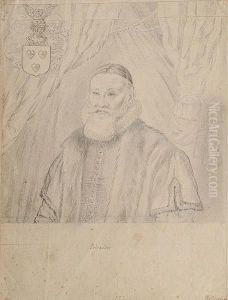Adriaen Matham Paintings
Adriaen Matham, born in 1590 in Haarlem, Netherlands, was a notable Dutch Golden Age engraver, draftsman, and painter, contributing significantly to the flourishing art scene of the 17th century. Coming from an artistic family, Matham was the son of the famed engraver Jacob Matham, who was himself a stepson and pupil of Hendrick Goltzius. This environment undoubtedly nurtured his talents and paved the way for his contributions to the art world.
Adriaen's work was diverse, encompassing not only engravings but also sketches and paintings, illustrating a wide range of subjects from portraits and landscapes to religious and mythological scenes. His style was deeply influenced by the baroque sensibilities of the time, characterized by dramatic expressions, rich detailing, and a keen eye for the interplay of light and shadow, which was a hallmark of Dutch Golden Age art.
Matham was not just confined to the Netherlands; his career took him on various journeys, including a significant trip to Morocco in 1640-1641. His travels influenced his work, broadening his repertoire to include scenes and subjects encountered during his journeys. This experience made him one of the few European artists of his time to have ventured into and depicted North African landscapes and peoples, adding a unique dimension to his body of work.
Despite the breadth of his work and his contributions to the Dutch Golden Age of art, Adriaen Matham is not as widely recognized today as some of his contemporaries. However, his engravings and artworks remain valued by collectors and historians for their craftsmanship and the window they offer into the artistic and cultural scenes of 17th century Europe. Adriaen Matham passed away in 1660, leaving behind a legacy that, while overshadowed by more prominent names of his era, is rich with the depth and diversity of his artistic endeavors.

